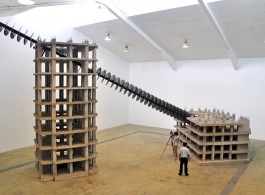Gallery statement: “Shen Yuan’s solo exhibition, “Sky Ladder” presents installations from the artist’s latest series, including several recent works never before shown in Beijing, such as “Nanling History 1957 – 2005”, “Spice” and “Crust”.
These works deal with architecture, nature and society based on the artist’s model of social development, reflecting her personal experiences and considerations of conflict, compromise, fusion and mutual support and their fragmented fragmented social status.
“Sky Ladder” consists of two unfinished buildings, resembling residential flats in a perpetual state of being ‘Under Construction’, never to be completed. A slow operating ladder moves between these two high and low buildings with drills in constant use – like having a life in slow-motion – as if to penetrate these two concrete structures that are determined to rise. Nietzsche once said, “The greatness of the man is that he is a bridge rather than an end point.” Similarly this ladder that constantly climbs may be seen as a metaphor for human beings, where the results of our growing struggle in life parallel the idea of a residential flat that is never completed.
“Nanling History 1957 – 2005” is a result of the Nanling Ruyang field research by Shen Yuan in 2005. As part of her research, she lived with local women for two months, and during her residency, she asked them to recall the transformed history of Nanling over nearly five decades and to write down their experiences. The artist also used the medium of watercolor to record the dried riverbeds and the surrounding forrest landscapes that were cleared. The entire process was video-documented. Though histories are often written by men, the history of remote Nanling has been written by the local women. The resulting history of the malignant development of this small place exemplifies a condensed version of modern China’s social development, one that has witnessed an industrial civilization overtaking nature, only to be overthrown by it. It is a pure portrayal of shortsighted desire by today’s societies that have permanently damaged our living environment.
“Spices” is an exhibition produced for Tang Contemporary Art Bangkok in 2010. In this installation, the artist filled the exhibition hall with red rose petals, and overlaid golden haystacks with white marigolds, to create the illusion of a field. Champs, the French word for ‘fields’ refers to both a harvest site and a battlefield. The artist carefully scattered pieces of red rose petals, along with areas of pure yellow flowers dedicated to a temple; these colors and scents of yellow and red bear deep meaning in the history of Bangkok, as a delicate female language. Mosquitos made of mosquito coils hung in the exhibition is a vicious metaphor, or perhaps a prayer, to drive away a once-bloody history. Here, Shen Yuan appropriately used materials of local Thai art to inspire interpretation and dialogue about the country’s social and political status.
“Crust” is the artist’s latest project – using natural Taihu prototypes as the original model. She creates a scene of high-rise buildings that grow adjacent to each other within the crevice of a stone. Like a skull covered with gems, or a scarred earth, this mixture of natural and modern architecture creates a cement monster, reflective of all the inevitable conflicts of modern life – between humans and the environment, and among our ecological resources.
In “Sky Ladder”, the artist tries to communicate her experiences of the relationships between urban society, people, and architecture. As she has articulated, “In human history, architecture has the closest relationship to human beings. It can be described as a sculpture of the human mind, though not of the artist’s…it more directly represents the human development: our desires, rights and politics.”
Upon finishing her study in traditional ink painting in China, Shen Yuan moved to France in the early nineties. Her inherent identity and perspective as a female, combined with the fusion of rich life experiences in the East and West, have made her sensitive to the state of lost language, and to the possibility of the body as a creative medium. Her creations often take us through the simple scenes of everyday life; using the language of metaphor and conversion. These large and spectacular scenes are immersed with delicate and profound qualities, yet reveal simultaneously the complexities of their visual semantics.”
